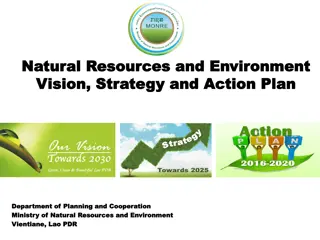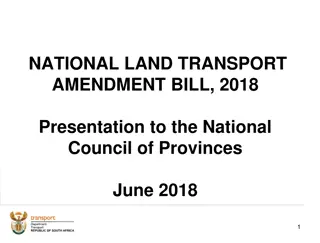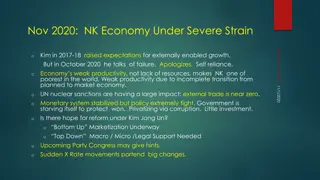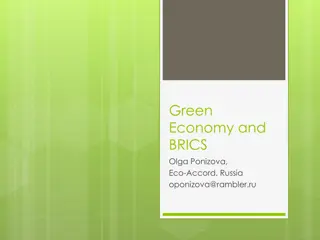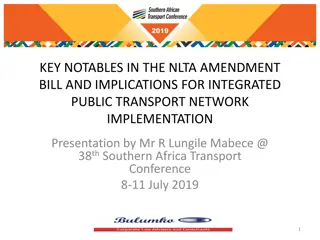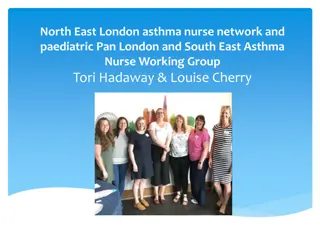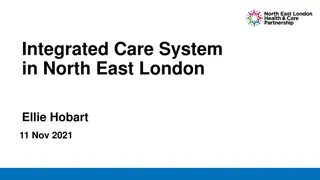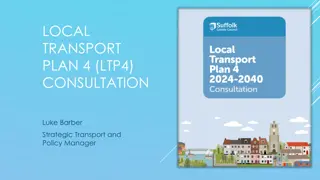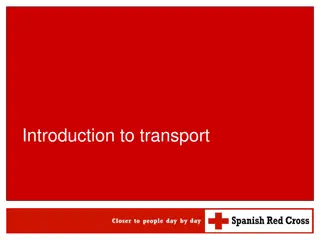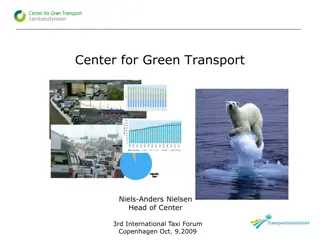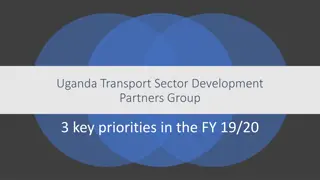Transport Vision and Objectives for North East Economy Growth
The vision for the transport system in the north east aims to create a cleaner, more resilient, and inclusive system contributing to improved quality of life. The objectives focus on sustainable transport access, reducing costs, improving health and wellbeing, and enhancing transport network safety and reliability to boost the region's economy.
Download Presentation

Please find below an Image/Link to download the presentation.
The content on the website is provided AS IS for your information and personal use only. It may not be sold, licensed, or shared on other websites without obtaining consent from the author. Download presentation by click this link. If you encounter any issues during the download, it is possible that the publisher has removed the file from their server.
E N D
Presentation Transcript
Members Workshop Wednesday 17thApril 2019 Woodhill House Aberdeen
2040 Vision To provide a clean, resilient, inclusive and accessible transport system in the north east, which contributes to improved quality of life through healthier, more prosperous and fairer communities
Four Pillars of the RTS Helping the north east economy prosper Improving health and wellbeing across the north east Taking action to reduce impact on climate change and protect the natural and built environment of the north east Promoting equality across the north east Equal and overlapping pillars In line with the four pillars of the National Transport Strategy
RTS Objectives 1 Increase access to a sustainable transport system for all, recognising the specific needs of disadvantaged and vulnerable users 2 Reduce the business costs of transport for all sectors of the economy to realise the aspirations of the Regional Economic Strategy 3 Reduce the adverse impacts of transport on public health and the natural and built environment 4 Improve the integration of transport and land use to reduce the need to travel by private car 5 Improve the relative competitiveness of public transport compared to the private car 6 Maintain and enhance a safe, resilient and reliable transport network
Pillar 1: Helping the north east economy prosper RTS Objective Pillar 1 Economy 1 Increase access to a sustainable transport system for all, recognising the specific needs of disadvantaged and vulnerable users 2 Reduce the business costs of transport for all sectors of the economy to realise the aspirations of the Regional Economic Strategy 3 Reduce the adverse impacts of transport on public health and the natural and built environment 4 Improve the integration of transport and land use to reduce the need to travel by private car 5 Improve the relative competitiveness of public transport compared to the private car 6 Maintain and enhance a safe, resilient and reliable transport network
Pillar 1: Helping the north east economy prosper Key themes: Improving connectivity within and to/from the region Access to key global markets Access to employment Transport related costs (goods and people) Journey times Journey reliability Reduced congestion / delays Attractive city and town centres Improving the resilience of the transport network in the face of disruption Embracing innovation and technology Perception of public transport Cost and availability of parking
Pillar 1: Helping the north east economy prosper Key baseline indicators from current RTS monitoring report 52% of the population lives within 5km of a railway station (2017) Journey time by rail to Edinburgh (2hrs 30) and Glasgow (2hrs 37) Many stations have seen significant growth in usage Bus passenger numbers are falling 11% travelling to work / education by bus (2017) 1% travelling to work / education by rail (2017) Traffic levels have been increasing since 2013 Journey times large disparity between car and public transport journey times
Pillar 1: Helping the north east economy prosper RTS 2040 - Discussion What outcomes should we be trying to achieve Consideration of targets / direction of travel to 2040 How are we going to achieve the desired outcomes Consideration of potential transport policies and actions
Pillar 2: Improving health and wellbeing across the north east RTS Objective Pillar 2 Health and Wellbeing 1 Increase access to a sustainable transport system for all, recognising the specific needs of disadvantaged and vulnerable users 2 Reduce the business costs of transport for all sectors of the economy to realise the aspirations of the Regional Economic Strategy Reduce the adverse impacts of transport on public health and the natural and built environment 3 4 Improve the integration of transport and land use to reduce the need to travel by private car 5 Improve the relative competitiveness of public transport compared to the private car 6 Maintain and enhance a safe, resilient and reliable transport network
Pillar 2: Improving health and wellbeing across the north east Key themes Quality and extent of the active travel network Reducing the conflict between traffic and active travel users Improving air quality (reducing emissions / alternative fuels) Reducing accidents / casualties Reducing the need to travel by private car Place making / designing attractive places that encourage active travel Increasing the mode share of public transport, cycling and walking Access to healthcare Improved quality of life and reduced social isolation
Pillar 2: Improving health and wellbeing across the north east Key baseline indicators from current RTS monitoring report 3 Air Quality Management Areas where pollutants exceed European limits Significant reductions in road casualties but 161 people killed or seriously injured in the north east in 2017 2% travel to work by bike in the north east (2017) 20% travel to work on foot in Aberdeen City, 13% in Aberdeenshire (2017) Park and Ride usage is falling Bus passenger numbers are falling
Pillar 2: Improving health and wellbeing across the north east RTS 2040 - Discussion What outcomes should we be trying to achieve Consideration of targets / direction of travel How are we going to achieve the desired outcomes Consideration of potential actions
Pillar 3: Taking action to reduce impact on climate change and protect the natural and built environment of the north east RTS Objective Pillar 3 Climate change & Environment 1 Increase access to a sustainable transport system for all, recognising the specific needs of disadvantaged and vulnerable users 2 Reduce the business costs of transport for all sectors of the economy to realise the aspirations of the Regional Economic Strategy Reduce the adverse impacts of transport on public health and the natural and built environment 3 4 Improve the integration of transport and land use to reduce the need to travel by private car 5 Improve the relative competitiveness of public transport compared to the private car 6 Maintain and enhance a safe, resilient and reliable transport network
Pillar 3: Taking action to reduce impact on climate change and protect the natural and built environment of the north east Key themes: Increasing the mode share of public transport, cycling and walking Adapting to the effects of climate change Improving the resilience of the transport network in the face of disruption due to severe weather Asset management and maintenance Taking steps to mitigate further climate change Alternative fuels and technologies Construction of new transport infrastructure and its impact on the natural and built environment
Pillar 3: Taking action to reduce impact on climate change and protect the natural and built environment of the north east Key baseline indicators from current RTS monitoring report 36 electric, hybrid and hydrogen fuelled vehicles in the Co-wheels car club fleet 10 hydrogen buses currently operating in the north east 2 hydrogen re-fuelling stations 85 publicly available electric vehicle charging points available (2018) 872 plug-in cars registered across the north east 34% of journeys made by modes other than the private car (2017)
Pillar 3: Taking action to reduce impact on climate change and protect the natural and built environment of the north east RTS 2040 - Discussion What outcomes should we be trying to achieve Consideration of targets / direction of travel How are we going to achieve the desired outcomes Consideration of potential actions
Pillar 4: Promoting equality across the north east RTS Objective Pillar 1 Equality 1 Increase access to a sustainable transport system for all, recognising the specific needs of disadvantaged and vulnerable users 2 Reduce the business costs of transport for all sectors of the economy to realise the aspirations of the Regional Economic Strategy 3 Reduce the adverse impacts of transport on public health and the natural and built environment 4 Improve the integration of transport and land use to reduce the need to travel by private car 5 Improve the relative competitiveness of public transport compared to the private car 6 Maintain and enhance a safe, resilient and reliable transport network
Pillar 4: Promoting equality across the north east Key themes: Fairness and reducing inequality Car ownership levels Public transport network coverage rural accessibility Public transport journey times Affordability Cost of public transport vs car travel and parking Accessibility of walking and cycling networks Accessibility of transport vehicles and facilities such as stations and interchanges as well as information provision Meeting the needs of young people and other vulnerable groups/protected characteristics Passenger experience when using public transport
Pillar 4: Promoting equality across the north east Key baseline indicators from current RTS monitoring report 20% of households in the north east do not have access to a car. 41% of taxis in Aberdeen City and 7% in Aberdeenshire are wheelchair accessible (2018) 89% of bus users satisfied with their overall journey 57% of bus users satisfied with value for money The cost of car parking is significantly cheaper than the cost of using the bus Journey times by public transport are generally not competitive with the car, particularly if interchange is required. 4 out of 9 stations currently meet desired accessibility standards
Pillar 4: Promoting equality across the north east RTS 2040 - Discussion What outcomes should we be trying to achieve Consideration of targets / direction of travel How are we going to achieve the desired outcomes Consideration of potential policies / actions
Next Steps o Continuing to develop RTS outcomes, targets and actions informed by: o Further consultation through the website and discussion papers o Consultation with key stakeholders o Ongoing work on the three research papers: o Demand management o Rural accessibility o Successful city region case studies








